On Saturday I played my third game in the Saturday Knights Marathon at Bay Area Chess. With so few players in the tournament (only four on Saturday), Thadeus and I knew that it was inevitable that we would play each other, and this gave me a chance to prepare for both 1. Nf3 and 1. c4, his standard opening moves.
It did seem a little awkward to play against a friend of mine in a rated game, but again that is bound to happen sooner or later. The awkwardness was more than compensated by the fact that we were able to study the game at leisure on Sunday night, with both Gjon and Cailen helping out. Usually these analysis sessions are one-sided; we only look at the position from one player’s point of view. But this time both players were present to tell us what they were thinking, and this led to some good psychological insights.
Thadeus “won” the middlegame and I “won” the endgame, so the result was a draw. The endgame in particular came down to a material balance I have not played before: two knights against a rook and two pawns. (I had the knights.) Ordinarily knights have trouble against a rook because they are short-range pieces and a rook is long-range. But what’s interesting about this endgame is that the two knights, when they are well coordinated, form a single organism, a sort of Siamese twin knight, and this “super-knight” is able to cope with the rook quite well because its influence stretches all the way from the h-file to the b-file.
Here are some of the key moments from the game.
Thadeus Frei — Dana Mackenzie
1. c4 e5 2. Nc3 f5 3. g3 Nf6 4. Bg2 Nc6 5. Nf3 Bb4 6. O-O Bxc3 7. bc!? d6
FEN: r1bqk2r/ppp3pp/2np1n2/4pp2/2P5/2P2NP1/P2PPPBP/R1BQ1RK1 w kq – 0 8
Thadeus’ move 7. bc (instead of 7. dc) was a little bit unusual but actually quite principled. This position has been reached 82 times in ChessBase, and I was shocked to see that not a single White player came up with Thadeus’ next move, a dynamic pawn sacrifice that may not even be a sacrifice.
8. c5!?
This move is thematic, of course, but usually White tries to set it up first. Thadeus asks, “Why bother?” If this sac is good, then Black’s 7th move really needs to be queried. Gjon convinced me that the more flexible 7. … O-O is a better option.
They say that the way to refute a sacrifice is to accept it, so of course I looked hard at 8. … dc. But after 9. Ba3, 9. … b6 is not an option. 9. … Qd6 or 9. … Qe7 looked scary because d4 might be coming (or 9. Qa4 Bd7 10. Qc4, which looks as if it wins the pawn back immediately). Probably the real test is 9. Ba3 e4, a very committing move that in general is questionable for Black, but in this position may be properly timed.
I opted for active piece play instead of passive defense with
8. … Be6?!
But this decision was debatable, too. I liked the idea of getting my bishop on the sensitive a2-g8 diagonal, keeping his queen out of b3 and also at least making it tricky for White to play Rb1 (although he did in fact play it). The trouble, though, is that 9. Ng5! Bg8 10. Rb1 is really awkward for Black to meet. If 10. … Rb8 simply 11. Rxb7! and White is much better.
Thadeus underestimated the strength of Ng5 and instead played
9. cd cd 10. Rb1?!
(10. Ng5! is still quite good). This was a very interesting part of the game psychologically. He actually thought that his position was inferior and thought 10. Rb1 was a weak move. Actually there is nothing wrong with it except for the fact that 10. Ng5 is better. I think the fact that he didn’t believe in his position explains why he didn’t play the ambitious 9. Ng5 or 10. Ng5.
10. … Qd7 11. Qa4 Nd8
Another interesting turning point. I thought and still think this move was best. Thadeus thought it was wrong and so he now started believing in his position! He thought 11. … O-O was right, because Black now has ideas of 12. … Nd4. However, he once again overlooked 12. Ng5!, which forces the win of bishop for knight (or else wins the b-pawn). If 12. … Nd4 now 13. Qd1 is a good answer. Amazing how Thadeus kept having a blind spot where the move Ng5 was concerned.
12. Qxd7+ Kxd7 13. a4 Bd5
FEN: r2n3r/pp1k2pp/3p1n2/3bpp2/P7/2P2NP1/3PPPBP/1RB2RK1 w – – 0 14
I’ve talked about Thadeus’ psychology, now let me talk a little bit about my psychology. As far as I was concerned, Black has just survived a near-death experience in the opening, and now I felt as if I had the “momentum.” My pieces are all getting centralized and my rooks will be connected in one more move. The bishop on d5 now neutralizes the most dangerous piece in White’s position, his bishop on g2. With my queenside finally secured, I can start turning my attention to the center or the kingside. Also, I thought his a-pawn might eventually be weak. All in all, I felt that Black was, if not better, at least comfortably equal and with a positive trend line.
Well, events proved that I was too optimistic about my position. But even before seeing what happened next, Gjon doubted my evaluation. And I think he is correct. If we imagine a lawyer advocating for the White pieces, he would first of all point to the two bishops — a very important factor in White’s favor. And the role of “most dangerous piece” actually switches from the g2 bishop… to the c1 bishop! We’ll see why in a few moves, but as a general rule, in two-bishop positions it is the unopposed bishop that is “the Monster.”
Another thing that the White advocate would point out is that the a-pawn will actually be a strong piece once it goes to a5. It’s hard for Black to attack that pawn, and on a5 it really ties down Black’s a- and b-pawns and makes the b7 pawn a chronic target. Finally, the White advocate would argue that Black has three weak pawns in his position (as Mike Splane would say, pawns that need to be defended by pieces): the b-pawn, the d-pawn, and (because of the position of Black’s king) the f-pawn. It doesn’t matter that they are defended now (well, except the f-pawn). What matters is that they need defending, and this hampers Black’s ability to play aggressively.
Oh, and one more thing. Where is Black’s alleged attack? What is he going to do with his space advantage? There’s not a single weakness in White’s position, aside from maybe (in the very, very long term) the a-pawn.
Conclusion: White has a slight advantage, and Black has to watch out to make sure his position doesn’t collapse like a house of cards.
It’s very interesting to see how my incorrect assessment leads to incorrect play.
14. d3 Bc6 15. a5 Ne6 16. Ba3 … (oh-oh!).
FEN: r6r/pp1k2pp/2bpnn2/P3pp2/8/B1PP1NP1/4PPBP/1R3RK1 b – – 0 16
And now I played a move that is not only bad, it’s embarrassingly bad. In retrospect it’s obvious that I need to attend to the defense of d6 pawn. But I was caught up in my narrative of “I have a space advantage, therefore I should attack on the kingside, and by moving his bishop he has just made it easier.” So I played
16. … g5??
with maybe 30 seconds of thought, at most. This is a psychological problem I run into now and then. Most of the time I am very deliberate and take too much time. But every now and then, at unpredictable points, I get impulsive and don’t think enough. I didn’t even think for one second about what that bishop was doing on a3.
17. Nd2!
Oh-oh!! Now, of course, it hit me big time. Nc4 is a huge threat, and Black is going to be forced back on defense. After spending 30 seconds on move 16, I now took 30 minutes on move 17, but it was too late. There was nothing to be done.
17. … Kc7 18. Nc4 Rad8?!
Technically this is a mistake and 18. … Ne8 is forced, but… Gag. Choke. Splutter. White is just going to load up on the b-file and squash me like a bug.
19. Bxc6 Kxc6
Even worse is 19. … bc 20. a6!
20. Nxd6 …
If White wants to get fancy, he can play 20. Bxc6 Rxc6 21. Nxe5!, which I think may be even better than the game variation. However, Thadeus’ move is natural and doesn’t require any calculation. In fact, he commented last night that he hardly did any calculating in the whole game. Which is quite an interesting comment. On the one hand you can use it as evidence that you can actually win a chess game without calculating any variations. But on the other hand, you can just as well argue that Thadeus’ big mistakes in the game came precisely in the spots where he should have calculated harder. I’m referring to the situation on moves 9-11 where he should have looked harder at Ng5, and the mistake yet to come on move 28.
20. … Rxd6 21. Bxd6+ Kxd6 22. Rxb7 …
FEN: 7r/pR5p/3knn2/P3ppp1/8/2PP2P1/4PP1P/5RK1 b – – 0 22
Here I knew I was completely lost, which was of course disappointing but had a paradoxical liberating effect. I’m now free to just play troublemaking moves, which is one of the things I do best. It started right here with
22. … Nc7!
Of course I didn’t want to play 22. … Ra8 23. Rf7, when White wins another pawn. The point of the text move is that 23. Rxa7 Rb8 traps White’s rook, and he will have to give up the a-pawn to free it.
23. R1b1 Ra8 24. d4?!
A micro-inaccuracy that shouldn’t have mattered, but it did. It gives my knights a tempo to get better organized, and doesn’t really improve White’s position in any way. In fact, when you look at the final position and ask how White’s formerly fluid pawn formation got so static, this is the move where it began.
24. … ed 25. cd Nfd5 26. Rb8 Rxb8 27. Rxb8 Nf6
FEN: 1R6/p1n4p/3k1n2/P4pp1/3P4/6P1/4PP1P/6K1 w – – 0 28
Here Thadeus made a tactical oversight that had its roots, I think, in a positional misjudgement. He think that the game is going to be easy. I think it is won for White, but it’s anything but easy. The route to victory is slow and painstaking: just play Kf1 and start the long trek with the king toward the queenside. The point is that the rook on b8 is in its perfect position. It cuts Black’s king off from the a-file, keeps the knights from harassing the a-pawn, and it’s ready at a moment’s notice to move to h8 or a8 if either of the knights should depart its current post. The position is actually a bit zugzwang-ish.
Instead, Thadeus played 28. Rb7?, thinking that I would be forced to play 28. … a6? 29. Rb6+ Ke7 30. Rc6 Nfd5, when 31. g4! is winning. (He actually didn’t calculate that far but just thought correctly that White was in complete control.) But instead I played
28. … Kc6!
Of course we’ve seen this trick before. White can take on a7 but he will be obliged to sacrifice his a-pawn to free his rook. Now there followed
29. Rb1 Nb5
and Black has made huge progress, as the rook is now shut out. Perhaps White can still win with computer-perfect play, but it’s getting very problematic. In fact, Gjon (who has played hundreds or thousands of games of bullet chess online) said, “If this were a bullet game, Black would be winning.” The knights just give Black so many cheapo opportunities. There’s a saying that I made up a few months ago and I’m trying to popularize: “Knights in time trouble are worth double.” Well, here there are two of them to begin with!
Actually, the “bullet” phase of the game is getting closer. I don’t know what the time situation was at this point exactly, but I would say it was roughly 8 minutes for me and 16 minutes for Thadeus. We were playing with a 5-second time delay, not 30 seconds.
30. e3 Nd5 31. Kg2 g4! 32. h3 h5 33. hg hg 34. Rc1+ Nbc3 35. Rh1 Nf6! ½-½
FEN: 8/p7/2k2n2/P4p2/3P2p1/2n1P1P1/5PK1/7R w – – 0 36
I offered a draw here, which Thadeus accepted after not too much thought. The time situation was 4-plus minutes for me, 8-plus minutes for him.
There are many reasons why the draw offer could not be refused, in spite of White’s time advantage. The main one is that ever since 29. Rb1, Thadeus has lost faith in his position. There are now very real ways that White could lose the game, if he allows me to win the a-pawn and mobilizes his own pawns too slowly. And how exactly is he going to mobilize those pawns? After, say, 36. Rh6? Ncd5, now he can’t play 37. f3 because Black will snatch the e3 pawn with check and then scoot back to d5. A better try is 36. f3 immediately, but even after a trade of pawns on f3, I can play … Ncd5 and the knights with the help of the f5 pawn set up a wall that neither White’s rook nor his king can penetrate easily.
As for me, from the practical point of view I think that this was exactly the right time for a draw offer. If I were leading on time then I should probably play on, but with just 4 minutes left it’s too big a risk. The last thing I would want would be to play the endgame so nicely, save what previously looked like a lost position, and then botch it with some horrific time trouble mistake.
I think the final position is a beautiful illustration of the power of the “Siamese twin” knights, which in spite of their short-range nature manage to control the board from sea to shining sea.

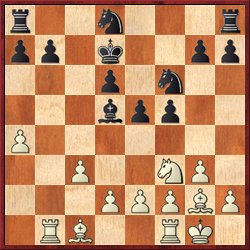
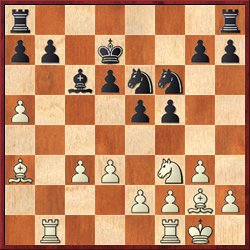
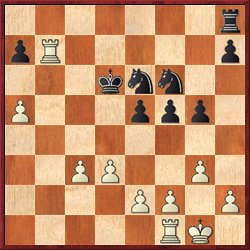
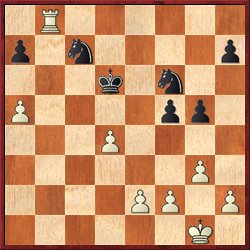
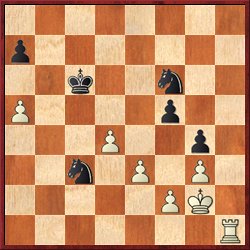



{ 2 comments… read them below or add one }
Hello Dana,
I was the player of the White pieces in a very similar game against Jon Goetz in 1980, including the idea of sacrificing a pawn with c4-c5. I assessed the position as favorable to White, due to the pressure on so many of Black’s pawns, so your suggestion about how I would assess the middle-game position is entirely accurate. Well done!
My game was published, with brief notes, in the August 1980 Michigan Chess Magazine, on page 16. Rather than retype the article, I took a screenshot of the notes, which I will send to you via email tonight.
Sorry I missed the game discussion. I was planning to come but Gjon and I miscommunicated. I didn’t know what time you were meeting.
This was a sudden death (+5 second increment) game, i.e. no “time control” to be made?
I think that has such a huge impact on the assessment of endings – increasing the value of N’s, as you point out, among other things.
{ 1 trackback }